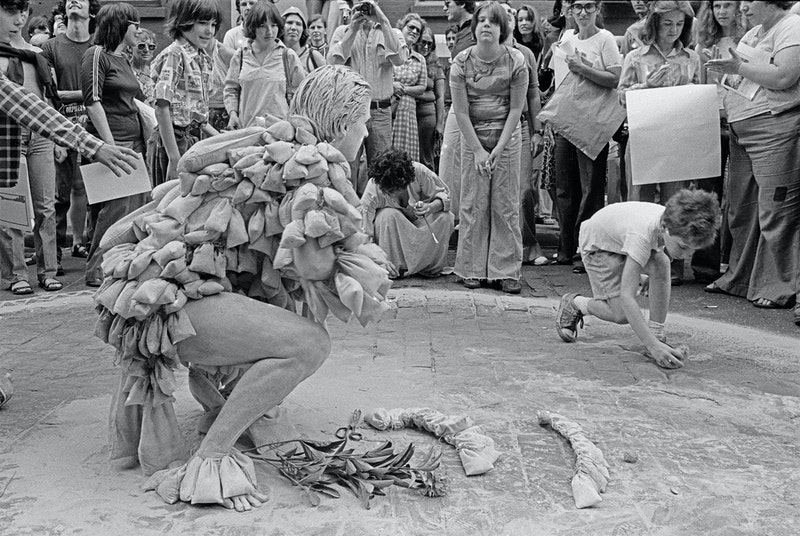 Betsy Damon, 7,000 Year Old Woman, performance on Prince Street, New York, May 21, 1977. Archival Print. © Betsy Damon 1977/2021. Courtesy the artist.
Betsy Damon, 7,000 Year Old Woman, performance on Prince Street, New York, May 21, 1977. Archival Print. © Betsy Damon 1977/2021. Courtesy the artist.
Betsy Damon: Passages: Rites and Rituals
By
Alex A. Jones
What function does art serve in society? There are always multiple answers to this question, all of which can be true at once. At different moments in space and time, however, certain functions of art have perhaps been extra salient. Art always reflects the creative (which is to say, the spiritual) needs of the collective. Thus art can illuminate historical consciousness, and vice versa.
The contemporary art that I grew up with, from postmodern to post-internet, seems to have principally served a social function of deconstruction. You could call it collective reckoning. In a world made ever-more complex by globalization and the rise of mass media, the creative tools of artists have served to detangle its complexities. This analytical function is reflected in the common praxis of contemporary art: interdisciplinary research as a dominant artistic strategy, critical engagement with history and subjectivity, and the inextricability of texts from visual media. In short, a complicated world has been mirrored by complex conceptual art.
But now, I am certain that a new paradigm is in the process of emerging, aligning art with a new social function. It comes forth in the context of collective crisis. Ecosystems are collapsing, the authority of capital forecloses all other priorities, liberal democracy has failed to assure human rights, and beyond the event-horizon of technological “progress” lies an equally alienating and inhumane frontier. These are not just the dooms of one pessimistic critic. “Humanity is failing,” read a banner over the River Clyde in Glasgow last week, an act of protest during the COP26 climate conference. The banner was flown by two German children, ages 10 and 11.
1
I believe their slogan is a sentiment shared by many artists of my generation, who now feel the deconstructive modes of conceptual art are insufficient. In times such as these, art must do more. It must evolve from modes of critique into modes of possibility, becoming an agent of change. In the broken world we now inherit, art must help us to heal.
Betsy Damon’s current solo show in New York successfully frames her as a pioneer of such a healing practice, and as a key artist through which to consider the relationship between art and activism. I first wrote about Damon’s work last summer in a review of the 2020 group show ecofeminisms, where her standout sculpture The Memory of Clean Water (1985) represented to me a sort of elegy for gallery-based practice in times of crisis. However, the current exhibition (curated by Monika Fabijanska) takes a retrospective look at Damon’s experimental performance works from the 1970s and ’80s that preceded the departure of her practice into eco-activism. The 12 projects on view include collaborative works of feminist theater, workshops and public meditations for women, and a Shrine for Everywoman at the United Nations World Conference on Women in 1980 and ’85. Collaboration, public engagement, and solidarity-building are central to all these projects, so that on the whole, the exhibition ties a powerful feedback loop between performance art and activism.
Damon’s breakout performance series was the 7,000 Year Old Woman (1977–79). It started as a quest to discover the lost collective history of women. The artist painted her skin in white makeup with black lips, and covered her body in little cloth sacks filled with 40-pounds of colored flour. She cut these open one by one to spill onto the ground, gradually exposing her naked or nearly-naked body. Beginning with a gallery performance in 1977, Damon subsequently took the character to the city streets, staging public happenings in SoHo and on Wall Street. As she wrote at the time, “so complete has been the eradication of things female from our streets that we do not miss them.”
Holding public space as the 7,000-year-old Woman was an emotionally difficult act, so much so that Damon said, “at a certain point I felt so exposed, I tried to put the bags back on.” Throughout one iteration of the performance on Prince Street, collaborator and painter Amy Siliman painted yellow triangles in a ring around Damon, creating a protective barrier while further underscoring her reclamation of space.
At the time of the performances, Damon recalls, everyone interpreted the 7,000-year-old woman as a goddess image. The character doubtless recalled the mysterious Roman cult statue Diana of Ephesus, covered in little sacs like breasts or eggs (or offertory testicles). But it was a limited reading, for a dead fertility goddess hardly constitutes a credible threat to modern patriarchal order—which is exactly what Damon intended for the work to do. With her white and black makeup, the
7,000 Year Old Woman is more like a ritual-clown, one who both amuses and frightens her audience into the ambivalent space of transformation. In the documentary photos through which the work is experienced today, we see a range of emotions on the faces of the crowd: some laugh at the weird woman on the ground while some solemnly watch. The artist recalls some boys throwing eggs.
Continue reading on the Brooklyn Rail site HERE